Disclosure: Meeple Mountain received a free copy of this product in exchange for an honest, unbiased review. This review is not intended to be an endorsement.
“So, you’re saying I need to close my eyes, then have another person pass me the die, THEN I have to bounce it onto that board?”
“Yes,” I replied to one of the players in my 6-player game of Dungeon Fighter (second edition, 2021, Horrible Guild). “But if you want to use those weapons you’ve acquired, you also have to do a 360 spin move then drop to the eye level of the table before closing your eyes, catching the die, then bouncing the die once off the table to make it land on the target area.”
This scenario actually happened. Dungeon Fighter was originally released in 2011 and updated with a crowdfunding campaign last year that provides not only a base game but FOUR expansions to keep the good times rolling.
Two things:
- If you don’t like dexterity games, you can stop reading this review now. This is easily the hardest dexterity game I have ever played, and this won’t be the dexterity game to draw you into this game format.
- If you like dexterity games and have friends who like playing games more than winning games—unless you are cheating, you are going to lose this game every single time you play it—Dungeon Fighter is a must buy. Often, you will lose badly. I never even made it to the final boss during my 4 plays before writing this review, and only made it to the final round once.
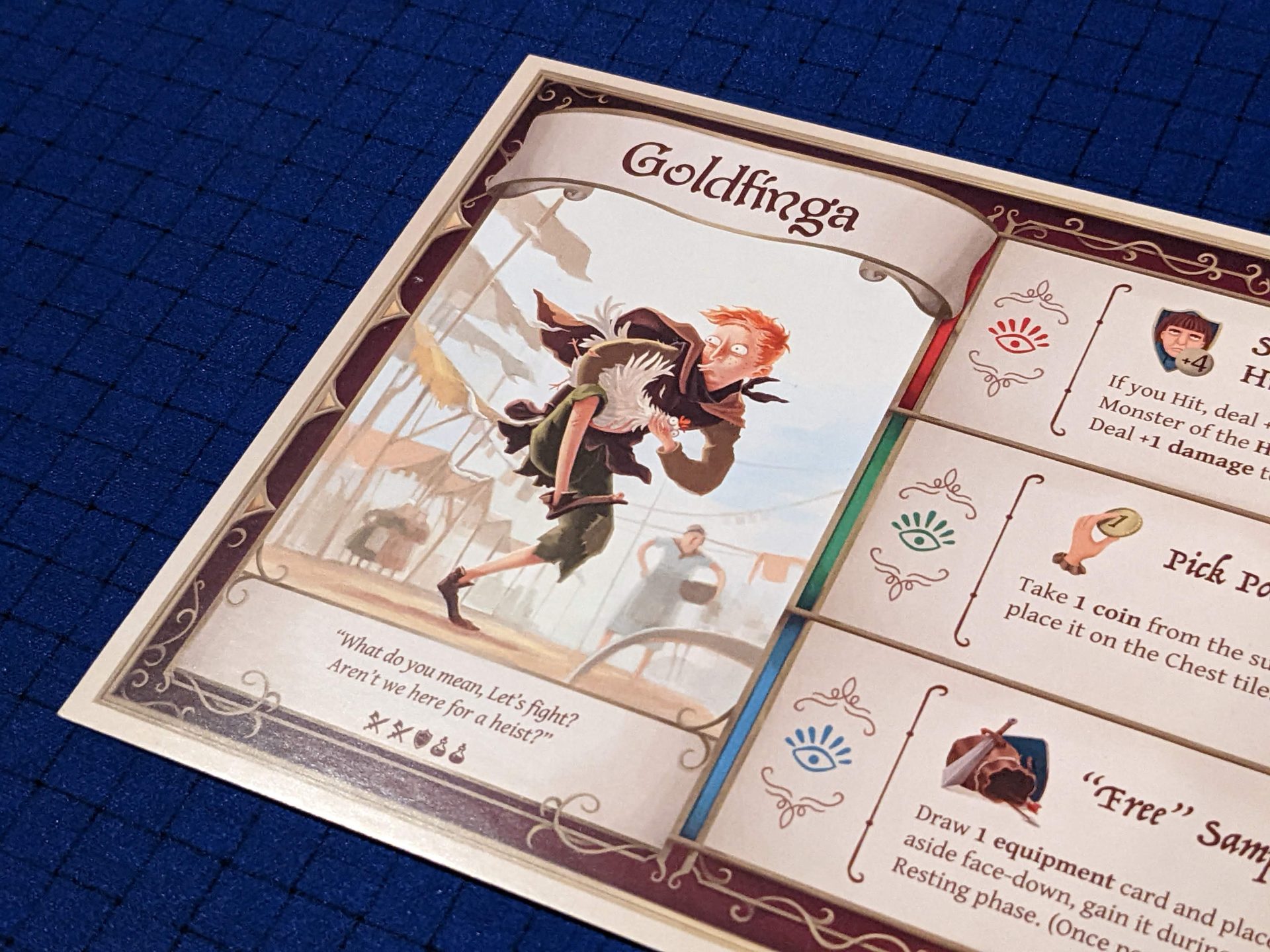
Roll Bounce (Err, Bounce, Roll)
Dungeon Fighter goes light, by poking fun at the dungeon crawler genre and keeping things buzzy with funny caricatures of “heroes” out looking for treasure. Up to 6 players enter the dungeon with the hope of surviving three rounds by fighting monsters, getting treasure to go shopping in between rounds, then fighting a final boss with a hit point cap so ridiculously high that I’m not even able to share with you what it feels like to face the end of a game.
You’re here because Dungeon Fighter does one thing masterfully well: the game makes hitting a target so hard that when it does happen, you will feel like pumping your fist and high-fiving a neighbor.
What’s the target? The “target” is a bullseye board that lies flat on your gaming table of choice, with rings aligned to the amount of damage (1-6 points) you’ll do to a monster depending on where the die rolls to a stop. There’s also a bullseye in the middle, and if the die lands there, you get to knock 10 points off of any monster. As an added bonus, if you bounce a die and it lands on the bullseye AND it lands with its special symbol face up, it instantly kills any monster in the game, no matter how many hit points it has.
I’ve never seen that happen, but the concept is dope.
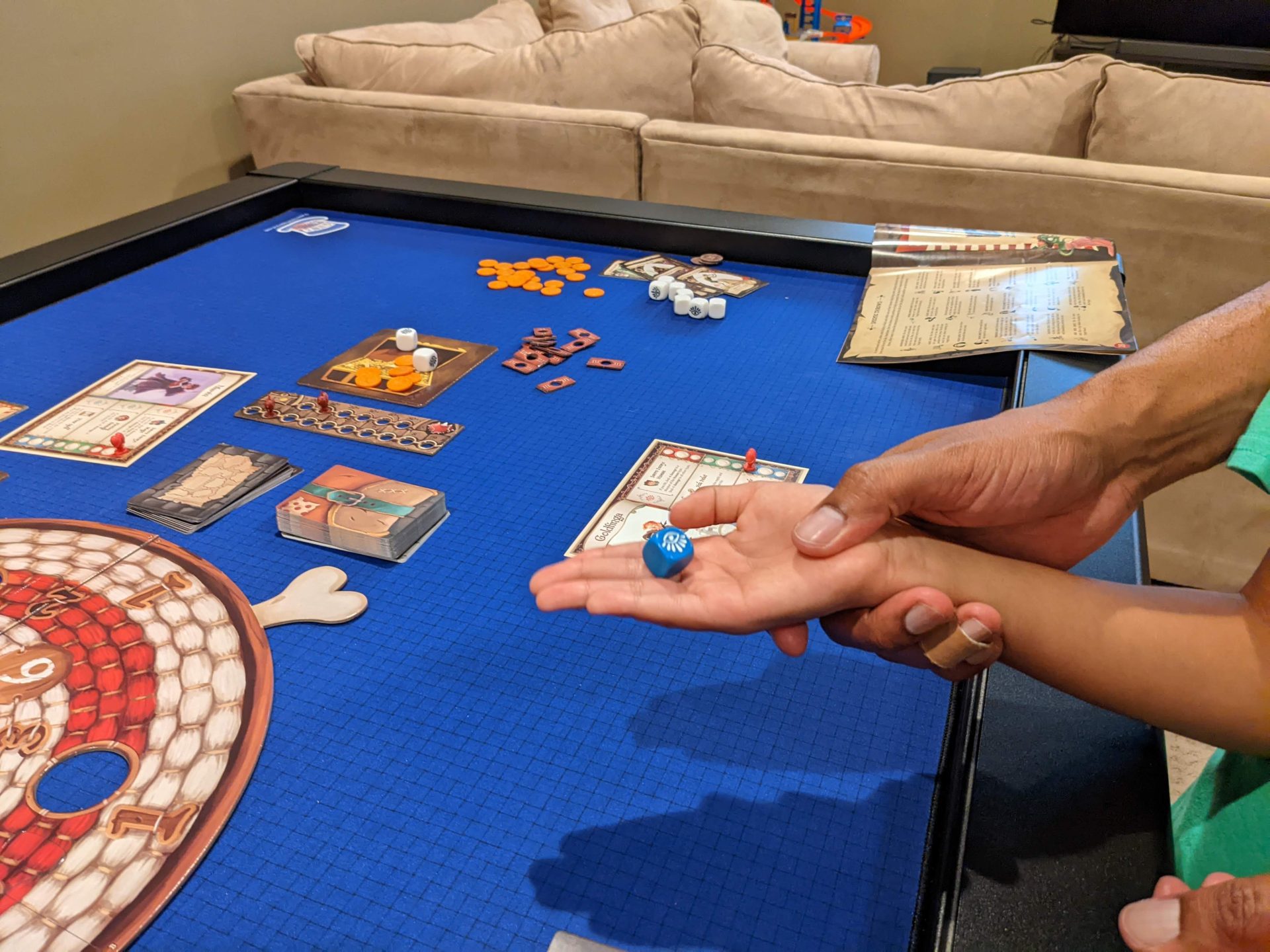
Here’s how a turn usually shakes out. A random player starts as the leader of your party, placed in charge of selecting one of the two dungeon cards that declare certain conditions for this turn only. Then, a monster is revealed from a deck of ever-more-difficult monsters standing in your way.
The player to the left of the leader is handed 3 colored dice, which is convenient, because that player has to pick one of these dice (colored red, blue, and green) that best aligns with one of the three powers on their player board. Each power grants a bonus if it comes up on its special symbol (each colored die is a 50-50 split between blanks and specials), so players decide who will roll which die.
Then, everyone looks at the conditions on the monster. Like the dungeon cards, the monster conditions are usually tied to making the monster have more health points or, worse/funnier, how you have to bounce the die to count as a valid turn.
And then, before aiming at the target board, a couple more things come into play. If you are holding any equipment cards—usually acquired by shopping in-between rounds with coins you’ve earned by beating baddies—those cards have certain conditions that need to be added if you want to score extra damage against the current monster.
So, another example from an actual game: a player had to factor in banking a die off of the box top, while doing a “prayer shot” (releasing a die from the middle of their palms, like they were praying) and doing that with their eyes closed. We were facing Puss in Sneakers (love the monster names and illustrations), so that meant Puss had the Tricky trait: all hits that land on a 1 damage ring count as a miss.
The die hit the target at a 2. High fives all around the table, fist bumps for the kids, who were just watching us play a game of Dungeon Fighter. (We still lost the game here, but still.)
These are the kinds of moments that happen during Dungeon Fighter, and even though you’re going to lose a lot, these are the highs that make the game worth playing. It is so hard to bounce a die and make it land even without all of the ridiculous conditions this game sets up.
But when you find a way to catch a “hot potato” die then do a “blow shot” towards the board and then the die actually bounces and you score damage to kill off a monster, you are gonna howl.
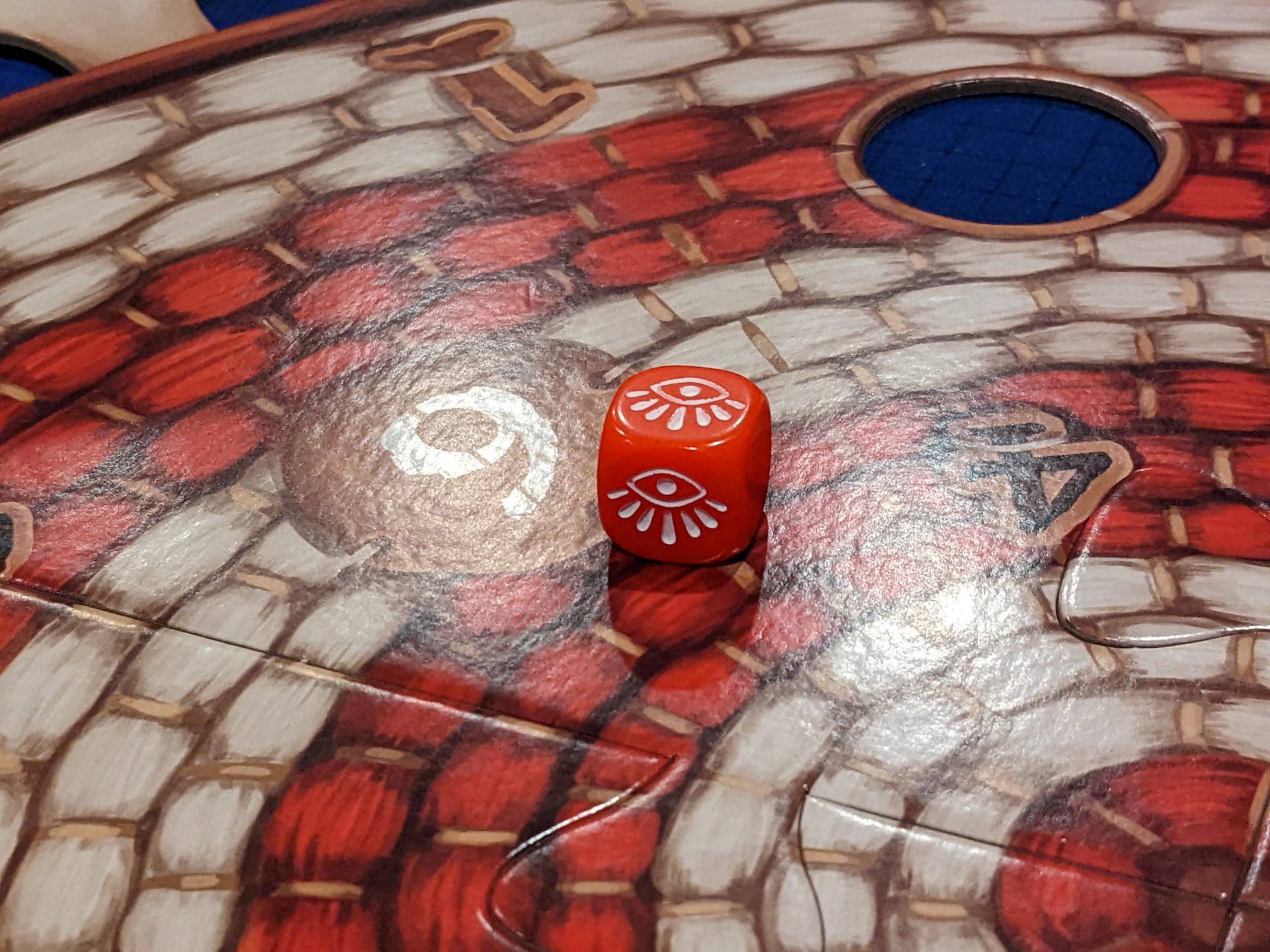
Difficulty? Let’s Start with Dark Souls
Dark Souls. Bloodborne. Super Meat Boy.
Let’s admit it: some people absolutely love video games that are so hard most sensible people would just give up. For those people, I invite you to try Dungeon Fighter.
You first have to be great at dexterity games, and I find that most board gamers are NOT good at dexterity experiences (see: Crash Octopus, Ice Cool, Men at Work, and older games like Jenga and Crokinole). You then have to be comfortable bouncing a die at a flat target, bounces which will fail more often than not. Then you have to add multiple conditions that make bouncing that die even harder.
Oh, and then? You have to know that if you bounce the die and miss, your player character (who started with 9 hit points) takes damage equal to a number on the monster card, anywhere from 1-3 damage for most of the monsters. Then you’ll take more damage every time the team has to collect back all of the colored dice to roll them a second, or third time during the same monster fight. (This can be temporarily mitigated if you have acquired bonus dice, but in my experience, bonus dice don’t help for long.)
The game ends in a loss if all players get KO’d in the same monster round. But even if that doesn’t happen, and, say, half of your squad does get KO’d and the rest don’t, those that did get killed off get a Scar, which permanently reduces their health by 2 and also blocks one of their 3 special abilities for the rest of the game.
And let’s pretend, for a moment, you get to the final boss. Boss health ranges from 25 to 40 HP. That is ridiculous as is, but some of the bosses have powers. Kitten Tamer, for example: if a player misses, all of the players take 3 damage.
Three straight misses, with no equipment cards to mitigate the damage, and that’s a guaranteed loss. Even if you keep hitting Kitten Tamer, it starts with 33 health. Your team is probably a goner anyway!
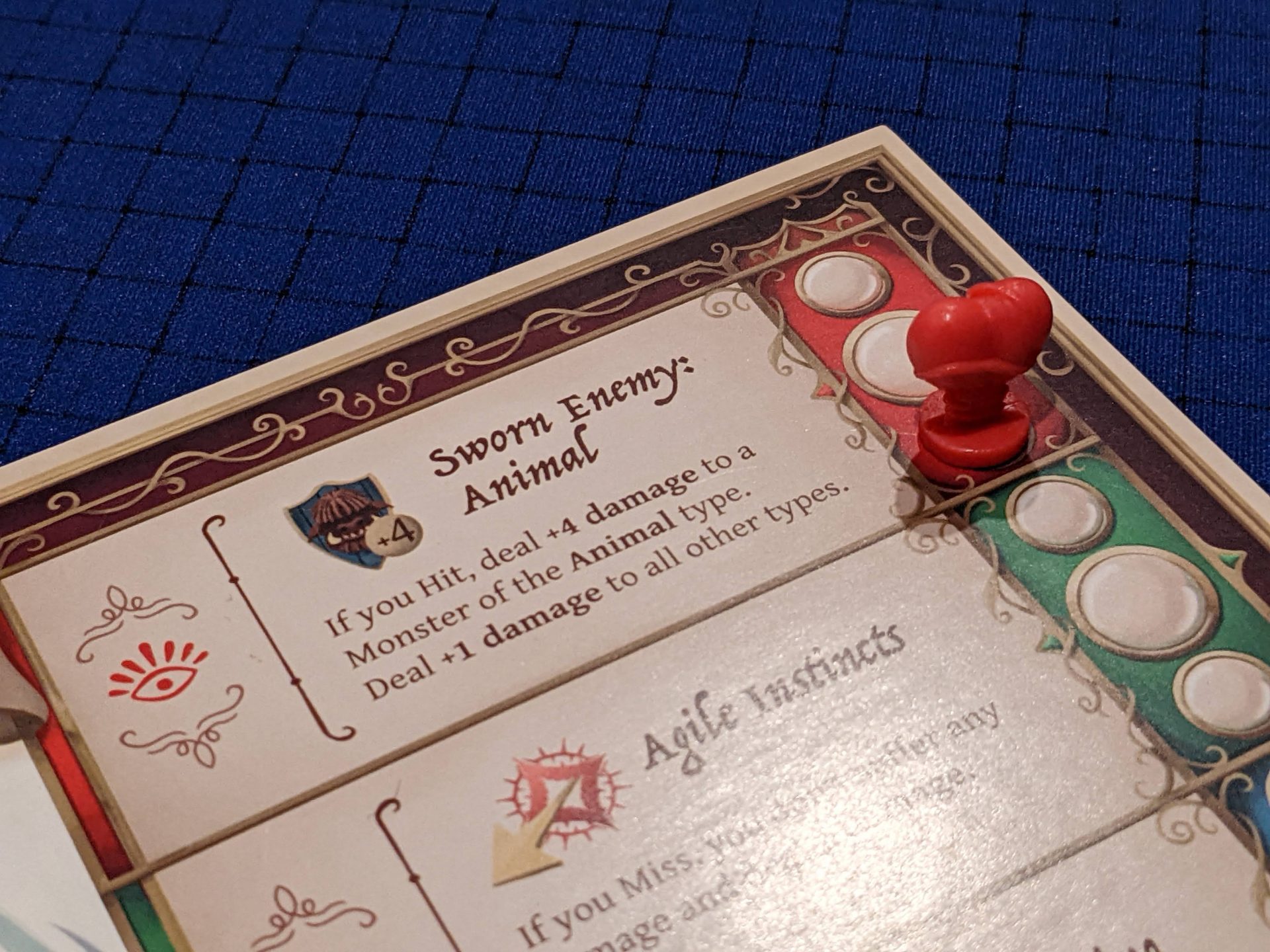
Sadists, Apply Here
You’re not beating Dungeon Fighter. You’re probably not coming close to beating Dungeon Fighter.
But life is about the journey, not the destination, right?
If that’s true, and you’ve got some friends willing to pony up to a table knowing full well that victory is not coming today, Dungeon Fighter is highly recommended. I played this twice solo (which is basically two-handing two separate characters), once at 4 players with my wife, the 8-year-old, and the 5-year-old, and once with 6 adult players.
Everyone spent their whole game laughing (even during my solos, as I laughed heartily at myself), and save for tricky iconography, the game is very easy to teach and breeze through turns. The box insert is top notch and the instructions, player boards, and cards all feature excellent writing.
But, like all games, Dungeon Fighter has its flaws.
The game should have an easy mode; in our house, we built an easy mode which just allows people to bounce the die on the target board (which softens up the bounce quite nicely) to make it land somewhere on that board. That was clutch for my 5-year-old, who was starting to get angry every time his die landed a couple feet from the board. I am also considering playing it on my basement carpet, to soften the die bounce when I try to hit the target.
The bonus dice really seem worthless; each costs two coins during the shopping round and only barely extend a fight that you are probably going to lose anyway…and, insult to injury, bonus dice only feature one special symbol on their six sides, making it almost impossible to trigger any of your special powers if they are rolled as a hit.
These minor issues aside, Dungeon Fighter is a fun time. Just know what you are getting into, and you’ll be in great shape!


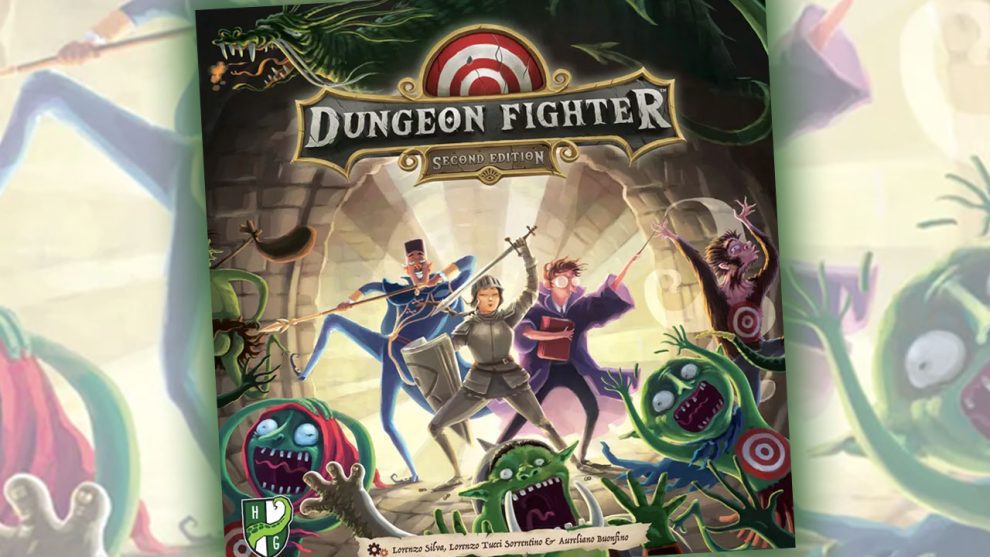


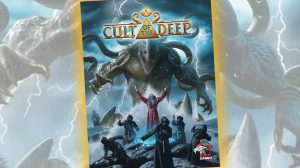

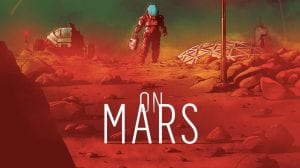




Ah yes, Dungeon Fighter. A game my group has thoroughly enjoyed since the introduction of the first edition, and you’ve accurately captured the silliness and difficulty. When we first played, I considered it a game of Dungeon Quarters, except with dice. Later, as Beer Pong (or whatever incarnation) grew in popularity, I thought of it as a pong-crawler. Even so, our group has won about 40-50% of our games, even at difficult mode. I didn’t do much of either Quarters or Beer Pong in college – 51 years sober – but we’re an exception to the IRL gamers characters with low dexterity. Always fun, and I’ve never regretted bringing it to the table as a cleanser between intense Euros or dudes on a map games.
Also, I highly recommend playing on a wooden table or (in our case) a marble top counter. Dice bounce much better off those surfaces. Fold-up tables, like standard card tables with cushion tops or plastic tables, suck too much life out of the dice.
Oh, and lastly, NEVER take whatever weapon(s) require you to bounce OVER a card. You’ll lose. Guaranteed. One person may get lucky once and clear the card before landing on the target, but unless it’s a special die face on the bulls-eye, game over. If you face a monster with that requirement… Bummer, man. Hope it was fun before that.
Love the advice; I may have to try a different table after all! Thanks for reading and hope you are enjoying the content on the site.
Was playing in two last night and we were really confused like “oh right now we take 2 damage.. and 3 more.. aaand we’re dead”. Glad to hear it’s not us but the game’s difficulty!
One thing about the review, Justin. You mentioned that the bonus dice really seem worthless. However keep in mind that you are not allowed to retrieve the colored dice in the final boss fight. So if you’re not stacked up on white dice you lose to the boss. Nonetheless, you have to get there in the first place, and it seems difficult to do that by saving 18 gold for 9 white dice 🤣
Great review, keep it up!